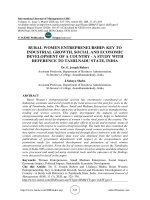Economic growth and economic development 85
Bạn đang xem bản rút gọn của tài liệu. Xem và tải ngay bản đầy đủ của tài liệu tại đây (145.15 KB, 1 trang )
Introduction to Modern Economic Growth
Proposition 2.8. Suppose Assumptions 1 and 2 hold and f (k) = af˜ (k). Denote the steady-state equilibrium level of the capital-labor ratio by k∗ (a, s, δ, n) and
the steady-state level of output by y ∗ (a, s, δ, n) when the underlying parameters are
given by a, s and δ. Then we have
∂k∗ (a, s, δ, n)
∂k∗ (a, s, δ, n)
∂k∗ (a, s, δ, n)
∂k∗ (a, s, δ, n)
> 0,
> 0,
< 0 and
<0
∂a
∂s
∂δ
∂n
∂y ∗ (a, s, δ, n)
∂y ∗ (a, s, δ, n)
∂y ∗ (a, s, δ, n)
∂y ∗ (a, s, δ, n)
> 0,
> 0,
< 0and
< 0.
∂a
∂s
∂δ
∂n
The new result relative to the earlier comparative static proposition is that now
a higher population growth rate, n, also reduces the capital-labor ratio and output
per capita. The reason for this is simple: a higher population growth rate means
there is more labor to use the existing amount of capital, which only accumulates
slowly, and consequently the equilibrium capital-labor ratio ends up lower. This
result implies that countries with higher population growth rates will have lower
incomes per person (or per worker).
2.5. Transitional Dynamics in the Continuous Time Solow Model
The analysis of transitional dynamics and stability with continuous time yields
similar results to those in Section 2.3, but in many ways simpler. To do this in
detail, we need to remember the equivalents of the above theorems for differential equations. Other useful results on differential equations are provided in the
Mathematical Appendix.
Theorem 2.4. Consider the following linear differential equation system
(2.34)
x˙ (t) = Ax (t) + b
with initial value x (0), where x (t) ∈ Rn for all t, A is an n × n matrix and b is a
n × 1 column vector. Let x∗ be the steady state of the system given by Ax∗ + b = 0.
Suppose that all of the eigenvalues of A have negative real parts. Then the steady
state of the differential equation (2.34) x∗ is globally asymptotically stable, in the
sense that starting from any x (0) ∈ Rn , x (t) → x∗ .
Proof. See Luenberger (1979, Chapter 2) or Simon and Blume (1994, Chapter
Ô
25).
71









